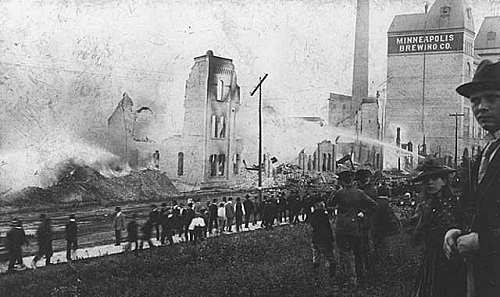The 1893 Nicollet Island-Northeast Fire
 Monday, April 12, 2021 at 6:44AM |
Monday, April 12, 2021 at 6:44AM |  Michael Rainville Jr |
Michael Rainville Jr | Article by Michael Rainville, Jr.
August 13th, 1893 was not a good day for the city of Minneapolis. It hadn’t rained for two months, the breeze was hot, and clouds were sparse. Just past 1:00pm, the infamous fire started when a few boys decided to have a quick smoke near the southwest side of Nicollet Island. The first building to catch fire was the Lenhart Wagon Works, and it didn’t take long before the Cedar Lake Ice House and stable and the Clark Box Factory were ablaze as well. Because of the arid conditions, the Minneapolis Fire Department did not want to take any chances. While they had crews fight the fires on the south side of the island, they also made sure to have a crew patrol the north side to quickly put out any embers and debris that floated away on this windy day and landed in the area.

When reinforcements were crossing the Hennepin Avenue bridge, they noticed a towering inferno at Boom Island, growing larger by the second. At the time, Boom Island was the heart of the log milling industry in Minneapolis, or in other words, the least desirable place for an uncontrollable fire. Now, how did a fire on the south side of Nicollet Island leap to Boom Island? As previously mentioned, it was a windy day, and when fires grow, the energy created can create even more wind. That seems like a sufficient explanation. However, there’s a rumor floating around that some of the log mill owners who lived on the northern part of Nicollet Island bought insurance plans for their companies a few years prior to the fire. Sure, the lumber industry was rapidly declining, and insuring your company would have been a smart move, but come on! Embers from a fire jump over half an island where log mill owners just happen to live, leap a river channel, and land where there’s dozens of acres of mills and lumber stacks? I’ll let the conspiracy theorists take over from here.

The fire spread north from Boom Island and was rapidly approaching residential areas, so the St. Paul Fire Department was called in to help fight the blaze. The plan was to stop the fire at Marshall Street from spreading east, and at 13th Avenue from spreading north. Thankfully, the fire itself did not take any lives, but roughly 24 square blocks of Northeast Minneapolis were reduced to rubble. It could have been a lot worse, but the brand-new metal and brick brew house of the Grain Belt Brewery, then known as the Minneapolis Brewing Company, stopped the fire dead in its tracks.
It took a long time for that area to recover, but since then, businesses moved back, homes were built, and trees sprouted from the ashes. When walking on the new, beautiful park trail from Sheridan Memorial Park to Boom Island Park, it’s hard to believe that Minneapolis’ biggest fire ravaged the area over 100 years ago.
- - - - - - - - - - - - - - - - - - - - - - - - - - - - - - - - - - - - - - -
 About Michael Rainville, Jr.
About Michael Rainville, Jr.
A 6th generation Minneapolitan, Michael Rainville Jr. received his B.A. in History from the University of St. Thomas, and is currently enrolled in their M.A. in Art History and Certificate in Museum Studies programs.
Michael is also a lead guide at Mobile Entertainment LLC, giving Segway tours of the Minneapolis riverfront for 5+ years.
He can be reached at mrainvillejr@comcast.net.
